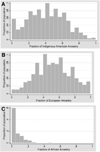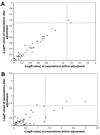Genetic ancestry and risk factors for breast cancer among Latinas in the San Francisco Bay Area
- PMID: 17035394
- PMCID: PMC5033763
- DOI: 10.1158/1055-9965.EPI-06-0092
Genetic ancestry and risk factors for breast cancer among Latinas in the San Francisco Bay Area
Abstract
Background: Genetic association studies using case-control designs are susceptible to false-positive and false-negative results if there are differences in genetic ancestry between cases and controls. We measured genetic ancestry among Latinas in a population-based case-control study of breast cancer and tested the association between ancestry and known breast cancer risk factors. We reasoned that if genetic ancestry is associated with known breast cancer risk factors, then the results of genetic association studies would be confounded.
Methods: We used 44 ancestry informative markers to estimate individuals' genetic ancestry in 563 Latina participants. To test whether ancestry is a predictor of hormone therapy use, parity, and body mass index (BMI), we used multivariate logistic regression models to estimate odds ratios (OR) and 95% confidence intervals (95% CI) associated with a 25% increase in Indigenous American ancestry, adjusting for age, education, and the participant's and grandparents' place of birth.
Results: Hormone therapy use was significantly less common among women with higher Indigenous American ancestry (OR, 0.78; 95% CI, 0.63-0.96). Higher Indigenous American ancestry was also significantly associated with overweight (BMI, 25-29.9 versus <25) and obesity (BMI, > or =30 versus <25), but only among foreign-born Latina women (OR, 3.44; 95% CI, 1.97-5.99 and OR, 1.95; 95% CI, 1.24-3.06, respectively).
Conclusion: Some breast cancer risk factors are associated with genetic ancestry among Latinas in the San Francisco Bay Area. Therefore, case-control genetic association studies for breast cancer should directly measure genetic ancestry to avoid potential confounding.
Figures


References
-
- Ries L, Eisner M, Kosary C, et al. SEER cancer statistics review, 1975–2002. Bethesda MD: National Cancer Institute; 2004.
-
- Le GM, Gomez SL, O’Malley CD, et al. Cancer incidence and mortality in the Greater Bay Area 1998–2002. Fremont CA: Northern California Cancer Center; 2005.
-
- Bertoni B, Budowle B, Sans M, Barton SA, Chakraborty R. Admixture in Hispanics: distribution of ancestral population contributions in the Continental United States. Hum Biol. 2003;75:1–11. - PubMed
-
- Hanis CL, Hewett-Emmett D, Bertin TK, Schull WJ. Origins of U.S. Hispanics. Implications for diabetes. Diabetes Care. 1991;14:618–627. - PubMed
-
- Bonilla C, Parra EJ, Pfaff CL, et al. Admixture in the Hispanics of the San Luis Valley, Colorado, and its implications for complex trait gene mapping. Ann Hum Genet. 2004;68:139–153. - PubMed
Publication types
MeSH terms
Substances
Grants and funding
LinkOut - more resources
Full Text Sources
Medical

